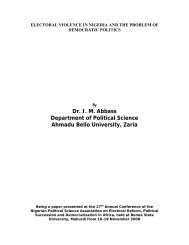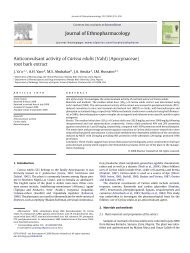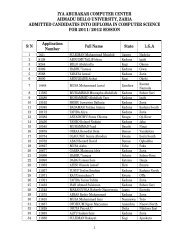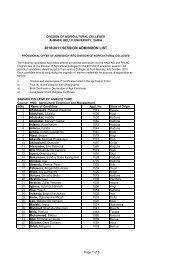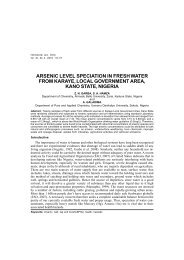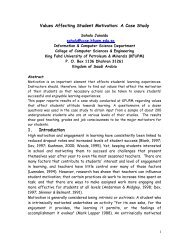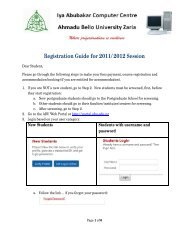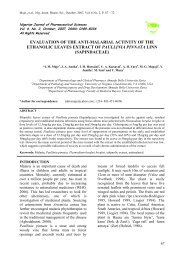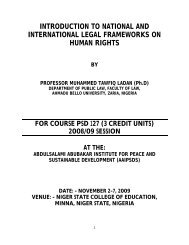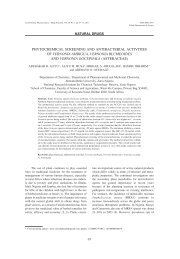FULL LENGTH RESEARCH PAPER - Ahmadu Bello University
FULL LENGTH RESEARCH PAPER - Ahmadu Bello University
FULL LENGTH RESEARCH PAPER - Ahmadu Bello University
Create successful ePaper yourself
Turn your PDF publications into a flip-book with our unique Google optimized e-Paper software.
Int. Jor. P. App. Scs., 2(4):1-5, 2008__________________________________www.ijpas.com<br />
INTERNATIONAL JOURNAL OF PURE AND APPLIED SCIENCES<br />
<strong>FULL</strong> <strong>LENGTH</strong> <strong>RESEARCH</strong> <strong>PAPER</strong><br />
Phytochemical and antibacterial properties of Ludwigia suffruticosa<br />
(Willd.) Oliv. ex. O. Ktze (Onagraceae)<br />
A.B. Aliyu, 1* A. M. Musa, 2 M. S. Abdullahi 3 and A. O. Oyewale 1<br />
1 Department of Chemistry, <strong>Ahmadu</strong> <strong>Bello</strong> <strong>University</strong>, Zaria-Nigeria.<br />
2 Department of Pharmaceutical and Medicinal Chemistry, <strong>Ahmadu</strong> <strong>Bello</strong> <strong>University</strong>, Zaria-Nigeria.<br />
3 Department of Leather & Biotechnology, National Research Institute for Chemical Technology- Basawa, Zaria-<br />
Nigeria.<br />
*Corresponding author’s e-mail: babandoaliyu@yahoo.com Phone: +2348057371917<br />
________________________________________________________________________<br />
ABSTRACT<br />
The antibacterial activities of the ethanol extract, ethyl acetate and n-butanol fractions of<br />
Ludwigia suffruticosa were evaluated using the disc diffusion technique against three<br />
gram-positive bacteria (Staphylococcus aureus, Bacillus. subtilis, Streptococcus<br />
pyogenes) and three gram-negative bacteria (Escherichia coli, Salmonella typhi,<br />
Klebsiella pneumoniae) using ampiclox and streptomycin as reference standards. The<br />
extract and fractions have demonstrated significant antibacterial activity. The ethanol<br />
extract was most potent against all the test organisms with zone of inhibition ranges from<br />
19.0-31.0mm (MIC, 30-50 mgmL -1 ), the n-butanol fraction; 19.0-21.7mm (MIC 40<br />
mgmL -1 ) was also active except on S. pyogenes and E.coli that displayed some resistance.<br />
Similarly, ethyl acetate fraction exhibited activity with zone of inhibition ranges 14.0-<br />
19.0mm (MIC 50 mgmL -1 ) on the organisms except on B. subtilis and K. pneumoniae.<br />
Phytochemical screening revealed the presence of flavonoids, tannins, steroids and<br />
saponins. The spectra of activities displayed by the extract and fractions can be<br />
attributed to the presence of these phytochemicals which signifies the potential of L.<br />
suffruticosa as a source of therapeutic agents and may provide leads in the on going<br />
search for antimicrobial agent from plants.<br />
Keywords: Ludwigia suffruticosa, antibacterial, phytochemical properties.<br />
________________________________________________________________________<br />
INTRODUCTION<br />
Medicinal plants have been used for centuries as<br />
remedies for human diseases because they contain<br />
components of therapeutic values (Nostro et al.,<br />
2000). About 80% of the world population relies on<br />
the use of traditional medicine which is<br />
predominantly based on plant material (WHO, 1993).<br />
The scientific studies available on a good number of<br />
medicinal plants indicates that promising<br />
phytochemicals can be developed for many human<br />
health problems (Gupta, 1994; Dahiru et al., 2005),<br />
including diabetes, cancer and infections diseases.<br />
The continued investigation into the secondary plant<br />
metabolites for anti-infective agents has gained<br />
importance because of the alarming increase in the<br />
rate of resistance of pathogenic microorganism to<br />
existing antibiotics. Therefore the need to develop<br />
efficient, safe and inexpensive drugs from plant<br />
sources is of great importance.<br />
Ludwigia suffruticosa (Onagraceae) or water primrose<br />
is an aquatic plant with a cosmopolitan but mainly<br />
tropical distribution. It is a robust, variable herb with<br />
leaves linear 1-2 mm broad and the stems are up to 2<br />
m high by 1 cm diameter (Burkill, 1997). In Northern<br />
Nigeria the plant is commonly known as Shashatau<br />
(Hausa). The plant is used as vermifuge, laxative, and<br />
1
Int. Jor. P. App. Scs., 2(4):1-5, 2008__________________________________www.ijpas.com<br />
for dysentery. It is believed to have analgesic<br />
properties alongside other drug-plants in the treatment<br />
of rheumatic pain (Hutchinson and Dalziel, 1953).<br />
Previous studies on Ludwigia hyssopifolia<br />
(Onagraceae) have indicated that an alkaloid 1-[5-(1,<br />
3-benzodioxol-5-yl)-1-oxo-2, 4-pentadienyl]<br />
piperidine, was isolated and found to exhibit<br />
antibacterial activity (Das et al., 2007). Thirteen<br />
chemical compounds: β-sitosterol, oleanolic acid, α-<br />
hydroxy ursolic acid, tormentic acid, daucosterol,<br />
maltol, luteolin, quercetin, apigenin, methyl<br />
brevifolincarboxylate, gallic acid, ellagic acid and 3,<br />
4, 8,9, 10-pentahydroxydibenzo [b, d] pyran-6-one<br />
(Yan and Yang, 2005) were also isolated from<br />
Ludwigia octovalvis. Although no pharmacological<br />
study has been reported on Ludwigia suffruticosa; this<br />
study was designed to evaluate the phytochemical and<br />
antibacterial properties of Ludwigia suffruticosa, in<br />
order to establish the molecular basis for some of its<br />
therapeutic properties in folkloric use.<br />
MATERIALS AND METHODS<br />
Plant material<br />
Whole plant of Ludwigia suffruticosa was collected in<br />
the month of February, 2006 at Samaru-Zaria,<br />
Nigeria. The plant was taxonomically authenticated at<br />
the herbarium of the Biological Sciences Department,<br />
<strong>Ahmadu</strong> <strong>Bello</strong> <strong>University</strong>, Zaria. A Voucher<br />
specimen (No. 917) was deposited there for future<br />
reference.<br />
Extraction and preliminary fractionation<br />
A 250 g weight of the powdered sample (aerial part of<br />
plant) was extracted exhaustively with 50% ethanol<br />
(cold extraction) for two weeks. The extract was<br />
filtered using Whatman filter paper no. 2, and<br />
concentrated at reduced pressure to afford 12.5 g of<br />
aqueous ethanol extract. 10 g of the extract was<br />
suspended in distilled water and partitioned with ethyl<br />
acetate (3 x 250ml) and n-butanol (3 x 250ml) to give<br />
a yield of 1.22 g and 1.35g respectively.<br />
Phytochemical screening<br />
Phytochemical screening of the extract and fractions<br />
were carried out to identify the constituents, using<br />
standard phytochemical methods as described by<br />
Harborne (1973), Trease and Evans (1989) and<br />
Sofowora (1993).<br />
Test organisms<br />
Six clinical bacterial strains: Escherichia coli,<br />
Klebsiella pneumoniae, Bacillus subtilis,<br />
Streptococcus pyogenes, Staphylococcus aureus, and<br />
Salmonella typhi were obtained from the Department<br />
of Medical Microbiology <strong>Ahmadu</strong> <strong>Bello</strong> <strong>University</strong><br />
Teaching Hospital (ABUTH) Zaria-Nigeria. The<br />
bacterial strains were maintained on nutrient agar and<br />
sub-cultured every three days. An inoculum of each<br />
bacterial strain was suspended in 5 ml of Mueller<br />
Hinton broth (MHB) and incubated overnight at 37<br />
ºC. The over night cultures were diluted with Mueller<br />
Hinton broth and adjusted to give a concentration of<br />
bacterial cells equivalent to a McFarland 0.5 standard<br />
prior to the bacterial testing (Samie et al., 2005).<br />
Determination of antibacterial activity<br />
The disc diffusion method was used (Nostro et al.,<br />
2000). Stock solution (100 mg mL -1 ) of each extract<br />
and fractions were prepared using the extractants.<br />
Disc (6 mm diameter) were prepared using Whatman<br />
filter paper and sterilized by autoclaving. The blank<br />
sterile discs were placed on the inoculated Mueller<br />
Hinton Agar (MHA) surface and impregnated with<br />
15µL of stock solutions (1500µg dics -1 ). Antibiotic<br />
discs of ampiclox (75µg dics -1 ) and streptomycin<br />
(30µg dics -1 ) were used as control. The plates were<br />
incubated at 37ºC for 24h. All tests were performed in<br />
duplicate and the antibacterial activity was expressed<br />
as the mean diameter of inhibition zones (mm)<br />
produced by the plant extracts.<br />
Minimum inhibitory concentration [MIC]<br />
Minimum inhibitory concentration was carried out<br />
using broth dilution as previously reported by<br />
Lennette et al (1974). Dilution (10-90 mgmL -1 ) of<br />
concentrations of extract and fractions that exhibited<br />
sensitivity against the test organisms were prepared<br />
using test tubes containing 9 ml of double strength<br />
broth. The test tubes were inoculated with the<br />
suspension of the standardized inocula and incubated<br />
at 37ºC for 24h. MICs were recorded as the lowest<br />
concentration of extract showing no visible growth of<br />
the broth.<br />
RESULTS<br />
The results of the phytochemical screening revealed<br />
the presence of flavonoids, tannins, steroids and<br />
carbohydrates in the ethanolic extract, ethyl acetate<br />
and n-butanol fractions. Saponin was present in only<br />
ethanolic extract and n-butanol fraction (Table 1). The<br />
ethanolic extract exhibit activity on all the test<br />
organisms producing zones of inhibition ranging from<br />
19.0-31.0 mm (Table 2). The activity was most on S.<br />
aureus (31.0 mm) and least on E. coli (19.0 mm). The<br />
ethyl acetate fraction also exhibited activity with zone<br />
of inhibition range 14.0-19.0mm except on B. subtilis<br />
and K. pneumoniae. Similarly, the n-butanol fraction<br />
was found to be very active with zone of inhibition<br />
range 19.0-21.7mm except on S. pyogenes and E. coli<br />
(Table 2).The minimum inhibitory concentration<br />
(MIC) showed that ethanolic extract exhibit the<br />
lowest MIC value 30 mgmL -1 against S. aureus, the n-<br />
butanol fraction exhibits 40 mgmL -1 against S. aureus,<br />
2
Int. Jor. P. App. Scs., 2(4):1-5, 2008__________________________________www.ijpas.com<br />
B. subtilis, S. typhi and K. pneumoniae. The ethyl<br />
acetate fraction however, showed MIC value of 50<br />
mgmL -1 against S. aureus, S. pyogenes, S. typhi and<br />
E.coli (Table 3).<br />
______________________________________________________________________________________________<br />
Table 1: Results of phytochemical screening<br />
Plant constituents Ethanol Ethyl acetate n-butanol<br />
Extract fraction fraction<br />
Alkaloids - - -<br />
Flavonoids + + +<br />
Saponins + - +<br />
Tannins + + +<br />
Steroids + + +<br />
Carbohydrates + + +<br />
+=positive<br />
- = negative<br />
Table 2: Results of Antibacterial activity of extract and fractions.<br />
Zone of growth inhibition (mm)<br />
Gram<br />
Test organisms<br />
+/-<br />
EE EAF NBF Ampiclox Streptomycin<br />
(75µgdics -1 ) (30µg dics -1 )<br />
S. aureus + 31.0 19.0 20.0 20 27<br />
S. pyogenes + 21.0 14.0 0 0 22<br />
B. subtilis + 27.2 0 21.7 30 30<br />
S. typhi - 20.0 17.0 19.0 0 0<br />
E. coli - 19.0 18.0 0 14 0<br />
K. pneumoniae - 22.2 0 21.0 0 20<br />
EE= Ethanol Extract, EAF = Ethyl acetate fraction, NBF = n-butanol fraction<br />
Table 3: Results of Minimum inhibitory concentration (MIC)<br />
MIC concentrations in mgmL -1<br />
Test organisms EE EAF NBF<br />
S. aureus 30 50 40<br />
S. pyogenes 40 50 NT<br />
B. subtilis 40 NT 40<br />
S. typhi 40 50 40<br />
E. coli 50 50 NT<br />
K. pneumoniae 40 NT 40<br />
EE= Ethanol Extract, EAF = Ethyl acetate Fraction, NBF = n-butanol Fraction, NT = Not tested<br />
______________________________________________________________________________________________<br />
3
Int. Jor. P. App. Scs., 2(4):1-5, 2008__________________________________www.ijpas.com<br />
DISCUSSION<br />
The crude extract and solvent fractions have<br />
demonstrated significant antibacterial activity. The<br />
ethanol extract was most potent against all the test<br />
organisms with MIC range 30-50 mgmL -1 . The lowest<br />
MIC (highest potency) exhibited was 30 mgmL -1<br />
against S. aureus (Table3). The antibacterial activities<br />
of ethyl acetate and n-butanol fractions showed good<br />
response on both gram-positive and gram-negative<br />
bacteria. Although gram-negative bacteria tend to<br />
have higher intrinsic resistance to most antimicrobial<br />
agents (Ndukwe et al., 2005); In spite of this,<br />
impressive activity against gram-negative bacteria<br />
was observed with ethyl acetate fraction (E.coli<br />
18.0mm, S. typhi 17.0mm) and n-butanol fraction (K.<br />
pneumoniae 21.0mm, S. typhi 19.0mm) (Table 2).<br />
The MIC exhibited by the ethyl acetate (50 mgmL -1 )<br />
and n-butanol (40 mgmL -1 ) fractions against the test<br />
organisms showed that the result was also remarkable.<br />
The potency of the extract and fractions based on the<br />
zones of inhibitions, compared with standard<br />
antibiotics such as ampiclox at 75µgdics -1 and<br />
streptomycin at 30µgdics -1 as shown in Table 2. It was<br />
however observed that the antibacterial activity of<br />
crude ethanolic extract is higher than those of the<br />
solvent fractions; which indicate that the activity may<br />
be due to combined effects of the fractions or<br />
synergism.<br />
Flavonoids, saponins, tannins and steroids were<br />
present in the extract and fractions. Antibacterial<br />
properties of several plant extracts have been<br />
attributed to secondary metabolites such as some of<br />
these (Cowan, 1999; Okoli and Iroegbu, 2005). Thus,<br />
the spectra of activities displayed by these extracts<br />
can be explained by the presence of flavonoids,<br />
tannins, saponins and steroids. It signifies the<br />
potential of Ludwigia suffruticosa as a source of<br />
therapeutic agents which may provide leads in the on<br />
going search for antimicrobial agent from plants.<br />
In conclusion, the significant activity exhibited by the<br />
extracts against clinical bacterial strains that are<br />
associated with various infectious diseases, may<br />
provide scientific justification for the ethnomedicinal<br />
uses of the plant.<br />
ACKNOWLEDGEMENTS<br />
To Mallam Umar S. Gallah for identifying the plant,<br />
and Mrs. Asiya Abba Mohammad of Federal College<br />
of Education, Zaria; for typesetting the manuscript.<br />
REFERENCES<br />
Burkill, H.M. (1997) The Useful Plants of West<br />
Tropical Africa Vol. 4. Families M-R,<br />
Royal Botanical Gardens, Kew. Pp. 306-<br />
307.<br />
Cowan, M.M. (1999) Plant Products as<br />
Antimicrobials Agents. Clinical<br />
Microbiology Review, 12(4):564-582.<br />
Dahiru, D., William, E.T. and Nadroi, M.S. (2005)<br />
Protective effects of Ziziphus mauritiana leaf<br />
extract on carbon tetrachloride-induced liver<br />
injury. African Journal of Biotechnology, 4<br />
(10):1177-1179.<br />
Das, B., Kundu, J., Bachar, S.C., Uddin, M. A. and<br />
Kundu, J.K. (2007) Antitumor and<br />
antibacterial activity of ethyl acetate extract<br />
of Ludwigia hyssopifolia Linn and its active<br />
principle piperine. Pakistan Journal of<br />
Pharmaceutical Sciences, 20(2):128-131.<br />
Gupta, S.S. (1994) Prospects and perspectives on<br />
natural plant products in medicine. Indian<br />
Journal of Pharmacology, 26:1-2<br />
Harborne, J.B. (1973) Phytochemical Methods: A<br />
guide to modern techniques of plant analysis.<br />
Chapman and Hall Ltd. London. Pp. 49-188.<br />
Hutchinson, J. and Dalziel, J.M. (1953). Flora of West<br />
Tropical Africa. Vol. 1 (1) 2 nd Edition,<br />
Crown Agents for Oversea, London, P.167<br />
Lennette, E.H., Spaulding, E.H. and Truant, J.P.<br />
(1974) Manual of Clinical Microbiology, 2 nd<br />
ed. American Society for Microbiology,<br />
Washington DC. Pp. 407-442.<br />
Ndukwe, K.C., Okeke, I.N., Lamikanra, A., Adesina,<br />
S.K. and Aboderin, O. (2005) Antibacterial<br />
activity of aqueous extracts of selected<br />
chewing sticks. Journal of Contemporary<br />
Dental Practice, 6(3):86-94.<br />
Nostro, A., Germanŏ, M.P., D’Angelo, V., Marino, A.<br />
and Cannattelli, M.A. (2000) Extraction<br />
Methods and Bioautography for Evaluation<br />
of Medicinal plants Antimicrobial activity.<br />
Letters in Applied Microbiology, 30:379-<br />
384.<br />
Okoli, S. and Iroegbu, C.U. (2005) In vitro<br />
antibacterial activity of Synclisa scabrida<br />
whole roots extracts. African Journal of<br />
Biotechnology, 4(9):946-952.<br />
4
Int. Jor. P. App. Scs., 2(4):1-5, 2008__________________________________www.ijpas.com<br />
Samie, A., Obi, C.L., Bessong, P.O. and Namrita, L.<br />
(2005) Activity profiles of fourteen selected<br />
medicinal plants from Venda Communities<br />
in South Africa against fifteen clinical<br />
Bacterial species. African Journal of<br />
Biotechnology, 4(12):1443-1451.<br />
Sofowora A, (1993) Medicinal plants and Traditional<br />
medicine in Africa. Spectrum Books Ltd,<br />
Ibadan, Nigeria. p. 289.<br />
Trease, G.E. and Evans, W.C. (1989)<br />
Pharmacognosy. 13 th (ed). ELBS/Bailliere<br />
Tindall, London. Pp. 345-6, 535-6, 772-3<br />
WHO, (1993) Regional Office for Western Pacific,<br />
Research Guidelines for Evaluating the<br />
Safety and Efficacy of Herbal Medicines.<br />
Manila. p. 2<br />
Yan, J. and Yang, X.W. (2005) Studies on the<br />
Chemical constituents in herb of Ludwigia<br />
octovalvis. Zhongguo Zhong Yao Za Zhi,<br />
30:1923-1926.<br />
5



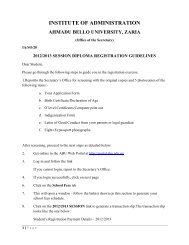
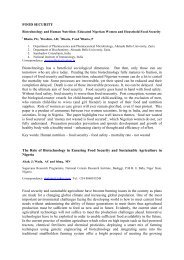

![Full Paper [PDF]](https://img.yumpu.com/49740055/1/184x260/full-paper-pdf.jpg?quality=85)
